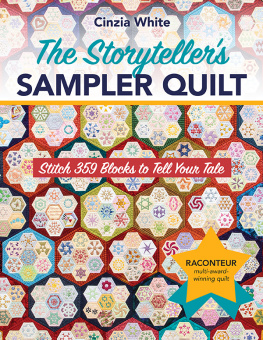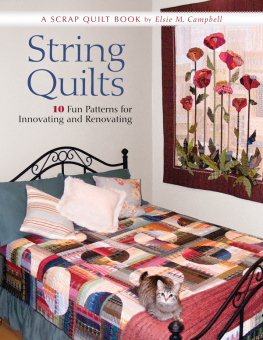Contents
Guide
ANIMAL QUILTS
12 Paper Piecing Patterns for Stunning Animal Quilt Designs
Juliet van der Heijden

www.sewandso.co.uk
CONTENTS
INTRODUCTION
I grew up in Edinburgh, but much of my childhood was spent enjoying the magnificent countryside of the Scottish Highlands. We would go for long hill walks, wade through rivers, pick wild berries and marvel at the heathers and wild flowers. My family spent what felt like an eternity birdwatching, peering through their binoculars in search of golden eagles, short-eared owls, buzzards, ospreys and all sorts of other amazing birds. Now, I must admit that as the youngest member of the family, I didnt always have the best attention span for birdwatching, but those hours spent enjoying nature left their mark on me. Although I didnt appreciate it at the time, they ingrained me with a deep-seated love of the outdoors and the wonders that can be found there.
Try as I might, I could never capture the beauty of birds and animals with pencil or paints, so it was a great joy to find my artistic canvas in quilting, and more specifically in foundation paper piecing. I discovered that the mix of creativity and logic involved in designing paper-pieced patterns suits my skills perfectly. It never fails to amaze me when I see the complex shapes that can be created just by sewing a series of straight lines. I cant resist the challenge of creating patterns which may appear complicated, but once the basics of the technique have been mastered, only require the sewer to be able to count and sew a straight line. Experience has taught me that a small change to the constructions of a pattern can make a huge difference to the ease with which it can be sewn. As such, I pieced all of the quilts in this book multiple times and tweaked the patterns until I was happy that they were constructed in the most logical way possible. My very first pattern was a butterfly and I quickly went on to discover a love of depicting animals and birds in fabric. It became a challenge to create creatures in my designs that had personality and jumped out of the fabric. I didnt want my designs to be lifeless and static.
The patterns in this book depict birds and animals from all over the world. I started the book with plans to limit myself to a specific region or species of birds or animals, but in the end I settled for no themes, no rules just the creation of the best possible set of quilts. Some are the result of very personal inspiration, others were designed for my family or as the result of a random spark of inspiration.
As I designed more and more patterns, I began to feel limited by traditional 12in blocks. The small size didnt allow me to add the amount of detail that I wanted and it restricted the types of fabrics I could use. By increasing the size, I discovered that I could make the patterns more elaborate and, excitingly, I could also be more adventurous with fabric. The smallest quilt design in this book is 21in x 14in, the biggest is 50in x 50in, with a wide variety of sizes in between. The designs can be used to create mini quilts, cushions, play quilts for babies, lap quilts and bed-size quilts. You can sew a single animal or sew multiple versions and combine them in a single quilt. The possibilities are both endless and exciting.
USING THIS BOOK
People often ask whether my patterns are suitable for beginners. Its a difficult question to answer as paper piecing can be a challenging technique for some people to learn, while others pick it up quickly and without problems. In general, I would suggest that it is probably better to learn the technique on simpler patterns than the ones in this book, but if you are an adventurous beginner, please dont let this put you off. I have tried to provide you with all the guidance you will need, but it is important that you read the early chapters on my foundation piecing method.
The Getting Started section of the book looks at issues directly related to paper piecing. Topics such as equipment you will need, how to paper piece, perfecting your technique and fabric choices are covered in depth.
The Projects section looks at the individual patterns. Instructions are given on the construction of the blocks as well as how to complete each quilt. Within each chapter there are two main diagrams provided to assist you (these are not to scale). A Colour Diagram of the project gives an overview of the sections that need to be pieced together and is a great reference when deciding which colour each individual piece should be. A Colouring Chart allows you to experiment with fabric colour choices and try out your ideas before committing them to fabric. These two diagrams are shown reversed, as foundation piecing is worked from the back of the printed design.
Within the General Techniques section, instructions are given on more general quilting techniques, such as adding borders, sewing binding and creating cushions. As such, this book talks you through every stage of the quilt-making process.
The patterns in this book vary in difficulty. Many of them contain a lot of fabric pieces, but are relatively straightforward to sew. Others need careful attention to detail when the paper sections are sewn together so that the outlines do not have bites taken out of them. In general, the larger the pattern pieces, the harder a pattern is to sew, especially when the fabric pieces on these sections vary greatly in size. Many quilters are almost as wary of Y-seams as they are of paper piecing. I can put their minds at rest none of my patterns have Y-seams.
PATTERNS
The paper pattern templates for all of the projects in this book, along with printable versions of the colouring charts and number diagrams, can be downloaded from: http://ideas.sewandso.co.uk/patterns.
- The Paper Pattern Templates have been formatted for A4 paper, but will also fit onto Letter paper. Pattern Assembly Diagrams are included to show how the templates are distributed on the page and will provide reference when gluing templates together.
- The Colouring Charts have two equally important purposes. For those wanting to try out different colour combinations, they can be printed and coloured in to help with fabric choices. For those with young children, the Colouring Chart can serve as a welcome distraction while Mum sneaks a few precious moments of quilting time!
- Number Diagrams. These place the pattern pieces within the context of the pattern as a whole. Although these diagrams can be printed out, I would suggest that they are best viewed on a computer screen where it is possible to zoom in and out and study all the relevant details. Some people may prefer to use this diagram as the Colouring Chart to as to keep all information together in one place, the choice is yours.
Please note that templates and diagrams have been provided for all blocks sewn in this book. As such, where mirror image blocks are required for a quilt, you will find all the relevant files for both a right-facing block and a left-facing block.
GETTING STARTED

EQUIPMENT
This section describes my workspace and the equipment that I use when creating my paper-pieced quilts.














